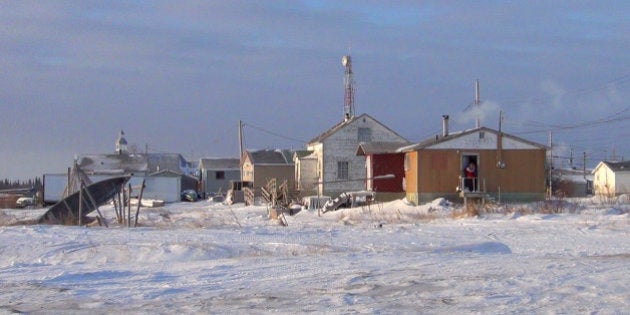
The state of emergency was declared on Oct. 28, 2011, by Attawapiskat's new chief, Theresa Spence. I had known her through her work on council. She didn't strike me as a firebrand or overly political. She was worried that, as the arctic winter descended on the community, people in these makeshift quarters could die.
Chief Spence asked me to speak with Minister John Duncan about a plan to deal with the immediate crisis of families living in tents and sheds. I spoke to him the day after the state of emergency was declared, and I asked him to send his officials into Attawapiskat to work with the community. He agreed, but then I never heard any more from him.
Days turned into weeks, and the temperature kept dropping. Officials from the regional office of Aboriginal Affairs spoke with the community about advancing some money to repair some of the condemned houses, but there was no offer to help get the families out of the tents and shacks.
In mid-November, Chief Spence and Grand Chief Stan Louttit became increasingly concerned as talks with the regional Aboriginal Affairs officials stalled.
They called on MPP Gilles Bisson, Dr. John Waddell of the Weeneebayko Health Authority, and me to come to the community to see the situation. I knew from past experience that nobody in the larger world would believe what was happening on the ground unless they had visual proof that the government couldn't deny. I brought with me a small digital video camera. As we toured the sheds, shacks, and construction trailers meeting residents, I filmed what we were witnessing.
We met Lisa-Kiokee Linklater, a young mother who lived in a tent with her husband and four young children. She had moved into the tent because there was no room left in a home that she had been sharing with 27 people. The tent was heated by a small woodstove, and the family slept on two mattresses on the floor. She had recently purchased the main family mattress for $1,000, and in the short time that they had been living in the tent the mattress had become infested with mould. When one of the children became frustrated, she would say that she was going to "her room": a little couch at the edge of the mattresses.
This family wasn't destitute. Linklater's husband had a good job as a heavy equipment operator, but they had been living in the tent for two years because there was no housing available in the community.
Conditions were even bleaker for others, particularly the elderly and sick. On one street corner, there were 15 people living in makeshift shacks with no running water or sewage. Elecricity came from strung-up extension cords attached to other houses. Human waste was dumped into the ditches. The shacks were heated with half-cut oil drums fed with wood. A face cord of wood in Attawapiskat sells for $150 to $200 and might last little more than a week. With winters that last longer than six months, these heating costs are enormous. For those too poor to purchase wood or too sick or old to cut their own in the territory, it made for dangerous conditions. One couple huddled in an unheated shed as the temperatures plunged. They lacked proper blankets, and the man, who was too sick to cut wood, was spitting up blood.
At the far end of town, many of the homeless were living in the De Beers construction trailers. Toddlers played in their long hallways, which looked like prison corridors. The image was appropriate: one young mother explained that the cells in the provincial jails were larger than the tiny room in which she was raising her children. The crowded families had to share the two sets of washrooms and one common kitchen. The possibility of a catastrophic fire in this rabbit's warren of rooms was a real concern.
I made a 10-minute YouTube video of what we witnessed. It was released along with an article in the Huffington Post entitled "What If They Declared an Emergency and No One Came?" As I noted in the article, "it's been three weeks since Attawapiskat First Nation took the extraordinary step of declaring a state of emergency. Since then, not a single federal or provincial official has even bothered to visit the community. No aid agencies have stepped forward. No disaster management teams have offered help."
The footage had an immediate impact on the Canadian public. The stark images shocked people and quickly went viral. Within days, the story was garnering national and international attention. The article was reposted 23,000 times on Facebook, and the video played on numerous news outlets both domestically and abroad. And still neither level of government moved. "In the three weeks since Chief Theresa Spence issued her frantic plea, they [the people of Attawapiskat] have been greeted with a sickening, baffling silence," wrote Bruce Urquhart in a syndicated column.
At the provincial level, MPP Gilles Bisson called out the McGuinty government for not sending Emergency Measures Ontario (EMO) into the community to assess the situation. He noted that, when a tornado hit the town of Goderich, EMO had arrived in the community within twelve hours. "They were on the scene immediately and that's all we're asking them to do, their job," he said. "Their mandate isn't to fix the problem, but to make sure people are safe."
Both Dr. John Waddell and Dr. Elizabeth Blackmore of the Weeneebayko Health Authority publicly warned that, as the temperatures plunged below minus twenty degrees, people could die. The Nurses' Association of Ontario urged both the federal government and the provincial government to take action. Its position was supported by the Ottawa Citizen's editorial board: "Nurses shouldn't have to beg our governments to do the right thing to save lives. . . . Canada doled out millions of dollars for manicuring Ontario cottage country for the G8 summit last year when the world was watching. But, as a country and province, we acted slowly and inadequately where it counts, . . . in a remote community with desperate needs."
Rather than respond to the crisis in Attawapiskat, Minister John Duncan continued to push the government's accountability agenda. An editorial in the Toronto Star summed up his misplaced sense of priority: "No housing. No clean water. No schools. But Aboriginal Affairs Minister John Duncan found time last week to reintroduce legislation to force public disclosure of chiefs' salaries. . . . Minister, really? Transparency is a good thing . . . but forging ahead with this in the face of true emergencies shows how badly misplaced the federal government's priorities are."
Despite the lack of action from the government, ordinary citizens, church groups, and other volunteer organizations stepped up to help. My office received calls from across the country from people who were fundraising to send supplies to Attawapiskat. But where to send the donations, they wondered. Without an establlished NGO to step forward and help, little could be done.
Canadians might well have remembered the different responses to two international disasters in recent years and have drawn comparisons. The first was the failure of the Bush administration to respond to the Hurricane Katrina disaster. Many uncomfortable questions about race and class were raised in analyses of the slow reaction to the situation in New Orleans. Now Canadians were watching a similar slow-moving response to a disaster unfolding in their own country. The second scenario was that of the immense humanitarian response from citizens and NGOs to the recent earthquake in Haiti.
Although the situation in Attawapiskat wasn't nearly as overwhelming as the catastrophe in Haiti, where were the NGOs to step in and help out this Haiti of the frigid north?
This is an excerpt from Children of the Broken Treaty by Charlie Angus.
MORE ON HUFFPOST:
